Seagull Survey (Part III)
Part three of Roxanne’s report on the yellow-legged gulls of Isla Perdiguera
This is the third article in a series of ten. If you haven’t already read the others, start with the first article!
For the full story of Roxanne’s hand-reared gulls and her study of the yellow-legged seagull colony on Isla Perdiguera, buy her book, Two Gulls and a Girl.
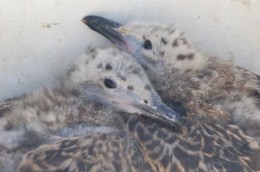 All this while Remus was as perky as ever and showed no signs of the fact that he had a pencil inside him. Still, I did not really think that he would continue to live. How could he live with a pencil longer than his stomach inside him? By now he was getting to be quite big. He is always hungry and he eats very, very quickly. Romulus is slow. He eats a little bit from the plate, and then I feed him some more, by hand. He does not have a very big appetite. I have to stop Remus from scoffing the lot, but although we think that Remus is huge he is not quite so big as his true brothers, on the island.
All this while Remus was as perky as ever and showed no signs of the fact that he had a pencil inside him. Still, I did not really think that he would continue to live. How could he live with a pencil longer than his stomach inside him? By now he was getting to be quite big. He is always hungry and he eats very, very quickly. Romulus is slow. He eats a little bit from the plate, and then I feed him some more, by hand. He does not have a very big appetite. I have to stop Remus from scoffing the lot, but although we think that Remus is huge he is not quite so big as his true brothers, on the island.
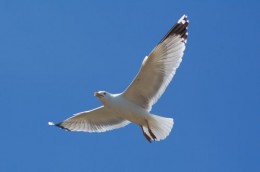 Usually I cannot find the chicks when they are more than three or four days old, but on the 22nd of April I found one of the chicks hiding in the bushes near to Remus’ nest (N9). Although he was heavier than Remus he didn’t have such advanced quills. While I was holding him the parents got very upset. They didn’t dive-bomb us, but they hovered above us looking very distressed and calling anxiously. Then one of them sicked up the contents of its crop. I suppose that must have been intended as the meal for her baby, but she was so upset that she dropped it from the sky. I hope he found it. I wonder if her behaviour was different from the other birds because she had already had a chick stolen? After we thought of that we put the chick back very quickly and went away, so as not to upset her any more.
Usually I cannot find the chicks when they are more than three or four days old, but on the 22nd of April I found one of the chicks hiding in the bushes near to Remus’ nest (N9). Although he was heavier than Remus he didn’t have such advanced quills. While I was holding him the parents got very upset. They didn’t dive-bomb us, but they hovered above us looking very distressed and calling anxiously. Then one of them sicked up the contents of its crop. I suppose that must have been intended as the meal for her baby, but she was so upset that she dropped it from the sky. I hope he found it. I wonder if her behaviour was different from the other birds because she had already had a chick stolen? After we thought of that we put the chick back very quickly and went away, so as not to upset her any more.
It seems that we need to feed Romulus and Remus more, but feeding them is already expensive. It is much more expensive than feeding the dog or the cat.
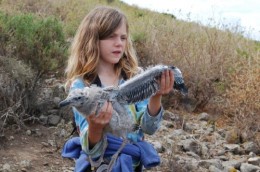 Whenever we go to the island I always visit all of my nests, and I record which ones have still got eggs and which ones have hatched. On the same day that I found Remus’ brother I also checked the nests just a bit further along, near Cormorant Beach. I found that the eggs in N8 had hatched and the chicks had gone, so I started to look for them. I was searching for them in a thick bush when I heard some rustling.
Whenever we go to the island I always visit all of my nests, and I record which ones have still got eggs and which ones have hatched. On the same day that I found Remus’ brother I also checked the nests just a bit further along, near Cormorant Beach. I found that the eggs in N8 had hatched and the chicks had gone, so I started to look for them. I was searching for them in a thick bush when I heard some rustling.
Thinking, “Here’s a chick,” I put my hand into the bush. But suddenly I thought, “What if it’s not a chick? It could be a rabbit. Or a snake.”
I quickly took my hand out of the bush. Then I heard a long, loud, rattling hiss come from the bush! I scrambled back to Mummy.
We poked the bush with a stick, and it hissed again. Mummy heard it too, very clearly. She can’t hear the small snakes, so it must have been a big one. We moved away and kept watch on the bush, one of us on either side, but the snake must have gone away a different way.
(This snake was probably the kind known to the locals as a culebra bastarda. In English it is called a Montpellier’s snake, and the Latin name is Malpolon monspessulanus. Although it can grow up to two metres long this snake is not especially dangerous to humans as his poison fangs are at the back of his mouth. If you are careless enough to tread on him he can’t do much about it – or so ’tis said… On the other hand, poking your fingers into a bush – and into the snake’s mouth – is definitely not a clever idea. JDS)
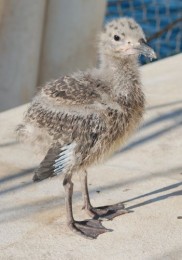 One morning when Romulus and Remus were about 22 days old and 20 days old we woke up and uncovered their box, and there was Romulus with real feathers on his wings! He looked lovely. The feathers were very dark brown and they were about an inch long poking out of his bluish coloured quills. The night before there had just been tufts poking out of the quills. Poor Romulus didn’t know what to do with his new wings. He didn’t know how to tuck them up and every time they fell down he would hitch them up again. It took him all day to get the hang of it, and then you couldn’t see the wings any more except when he flapped them.
One morning when Romulus and Remus were about 22 days old and 20 days old we woke up and uncovered their box, and there was Romulus with real feathers on his wings! He looked lovely. The feathers were very dark brown and they were about an inch long poking out of his bluish coloured quills. The night before there had just been tufts poking out of the quills. Poor Romulus didn’t know what to do with his new wings. He didn’t know how to tuck them up and every time they fell down he would hitch them up again. It took him all day to get the hang of it, and then you couldn’t see the wings any more except when he flapped them.
Then Remus started to get his wing feathers too. Both birds had feathers coming all over them, and for the next week they spent the whole time twitching about and preening themselves, to get rid of the fluff and the bits of quill. From the way they were behaving it looked as if getting feathers must be a very itchy process! There were little tiny bits of quill blowing aound and settling all over the boat.
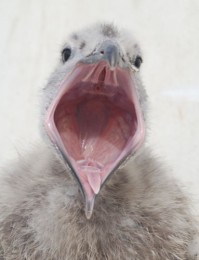 On April the 23rd I was standing in the dinghy, pumping it, when I heard my brother shouting at the birds. The birds spend the day in the cockpit, on one of the seats, and Caesar was on deck too, using his computer. While I scrambled out of the dinghy a thought flashed through my mind – “What now? Remus has already swallowed a pencil. Before that he nearly died coming out of the egg. How many lives has he got?”
On April the 23rd I was standing in the dinghy, pumping it, when I heard my brother shouting at the birds. The birds spend the day in the cockpit, on one of the seats, and Caesar was on deck too, using his computer. While I scrambled out of the dinghy a thought flashed through my mind – “What now? Remus has already swallowed a pencil. Before that he nearly died coming out of the egg. How many lives has he got?”
But Remus was not falling in the sea or swallowing something new. He was sicking something up. That was what my brother was shouting – “Pencil! Pencil!”
Mummy leapt up from the cabin. The pencil was half out of Remus’ mouth, and the silly boy was trying to swallow it again!
Mummy grabbed him and held his neck tightly, so that he could not swallow. His mouth was open, because he was yelling, and she put her fingers in and was just able to get hold of the very tip of the pencil lead and pull it out.
It all happened so quickly that by the time I was out of the dinghy Mummy was already back in the cabin waving the pencil around. It was exactly as it had looked 10 days earlier. It was lucky that it was a drawing pencil, so not terribly sharp. It still had the little rubber in the other end.
While we looked at it Remus was still outside in the cockpit cheeping loudly in protest, saying “Give me back my dinner!”
(If you click on the photo of Remus, to enlarge it, you can see the amazing construction of the seagul’s mouth. Note the pink “teeth” in the roof and on the floor of the gape. These are evidently intended for gripping wriggling fish. JDS)
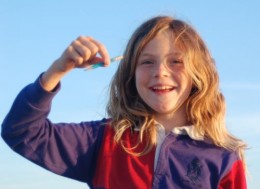 Since this time Remus has also swallowed a large plastic clothes peg, which fell off the washing line and into the cockpit. He ate it before anyone could get it, but he brought this up again about an hour later. He also tried to eat a nail brush, but I pulled it out of his mouth. Would he behave like this if he lived in a nest? Do other chicks eat sticks and stones?
Since this time Remus has also swallowed a large plastic clothes peg, which fell off the washing line and into the cockpit. He ate it before anyone could get it, but he brought this up again about an hour later. He also tried to eat a nail brush, but I pulled it out of his mouth. Would he behave like this if he lived in a nest? Do other chicks eat sticks and stones?
One afternoon Remus started panting. I thought that he was too hot. I always make sure that the birds have sunshine and some shade, but they are not always very sensible about standing in the shade. I took the birds inside, but Remus carried on panting. We decided he might be ill, and so we put the two birds in different boxes, so that Romulus wouldn’t catch the illness. But it was hard to see how Remus could have caught anything. Daddy suggested that he might be thirsty – and it turned out to be true. Mummy was very puzzled, because she says the birds on the island don’t have access to any water. But perhaps their parents when they regurgitate food bring them water too. We gave Romulus and Remus a big bowl of water and they both drank from it eagerly. Then they climbed into the bowl and succeeded in getting themselves completely soaked.
After this we gave the seagulls a bird bath. They love it! As soon as I put the bath down they jump into it at once, even before I’ve poured in the water! They put heir heads under the water and splash about. The water immediately gets filthy. It gets covered in bits of fluff and quill.
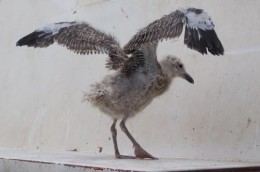 On the 27th of April Remus weighed 800g. He had become absolutely huge. Mummy joked that he was acually an ostrich chick! Within less than one month he had grown from a tiny fluffy little chick to a great big feathered bird, nearly as big as an adult. Xoë doesn’t want him any more, even though she helped to hatch him.
On the 27th of April Remus weighed 800g. He had become absolutely huge. Mummy joked that he was acually an ostrich chick! Within less than one month he had grown from a tiny fluffy little chick to a great big feathered bird, nearly as big as an adult. Xoë doesn’t want him any more, even though she helped to hatch him.
“They were so fluffy and small,” she says, “And now they’re just two ugly monsters.” She would like to swap our babies for two more cute little fluff balls.
But Romulus and Remus are not ugly at all, they are beautiful! They have feathers all over them now, especially Romulus. He has a coat of pale brown and dark brown feathers, lovely big wings, and a black and white tail. But Remus still has some fluff round his neck and they both still have some fluff on their heads.
Although he is two days older and so has the best feathers, Romulus is much smaller than his step-brother. While Remus weighed 800g Romulus only weighed 650g, and when Remus kneels down, which young seagulls do a lot, he is still as tall as Romulus – or even taller!
On the 7th of May Romulus weighed 750g but Remus weighed 1,000g / 1kg. It is very difficult to make them stand still on the kitchen scales. We had to buy new scales that are less wobbly.
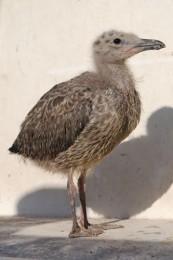 Perhaps it was that sugar-water that we gave him when he was newly hatched which has made Remus grow into such a big strong bird! Actually, Mummy and I think it is because one bird is male and one is female. It can’t just be because Remus eats more. It is true that he is very greedy, but I always make sure that Romulus gets his fair share. Mummy thinks that Remus is a male and Romulus a female. I think it is just as likely to be the other way around. In animals females are often bigger than males.
Perhaps it was that sugar-water that we gave him when he was newly hatched which has made Remus grow into such a big strong bird! Actually, Mummy and I think it is because one bird is male and one is female. It can’t just be because Remus eats more. It is true that he is very greedy, but I always make sure that Romulus gets his fair share. Mummy thinks that Remus is a male and Romulus a female. I think it is just as likely to be the other way around. In animals females are often bigger than males.
The other thing that suggests they may be male and female is the beak length. Romulus has a fairly short beak and Remus a longer one. After seeing this with our chicks I started looking at birds on the island, both the chicks and the adults, and there are definitely two beak lengths, the long and the short. But which one is male and which is female?
(We have now spent some time rummaging around on the world wide web and have discovered that yellow legged gulls are indeed, “sexually size dimorphic”, as the scientists would have it. Boys are bigger. The sex of the chick is apparently determined by the condition of the mother. If she has been eating well her egg is likely to develop into a male. Does this mean that a well-fed mum will produce three fine boys, we wonder, or are we talking about daily variations in her nutrition? Oddly enough, it would seem that the male chicks are less likely to survive than their little sisters. JDS)
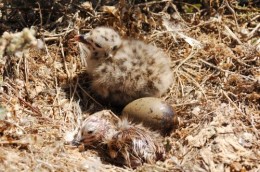 All the eggs are hatching on the island now. We have watched one of the eggs in N52 from the moment when the first crack appeared in the shell, to the beak sticking out, and then the back sticking out, and then finally a tiny wet helpless chick lying in the bottom of the nest. Since the wind was blowing onshore and making the egg cold we had to watch this in stages. We had to make sure that the mother could return to the nest and keep her baby warm, but we went back every hour to see how things were going. It took around four hours from the time when the beak was sticking out to the time when the chick was fully hatched. One of the other chicks was already hatched when we watched this egg. Ten days later, on the 22nd of April, we found two chicks from this nest hiding in different bushes, each about 3 metres from the nest. We can sometimes watch this nest from the boat, depending on where we anchor, because it is right on the shore, and we often see the two chicks and their mother. We don’t know what happened to the third egg, as we had to go away from the island next day. Perhaps it hatched and died, or perhaps it was taken.
All the eggs are hatching on the island now. We have watched one of the eggs in N52 from the moment when the first crack appeared in the shell, to the beak sticking out, and then the back sticking out, and then finally a tiny wet helpless chick lying in the bottom of the nest. Since the wind was blowing onshore and making the egg cold we had to watch this in stages. We had to make sure that the mother could return to the nest and keep her baby warm, but we went back every hour to see how things were going. It took around four hours from the time when the beak was sticking out to the time when the chick was fully hatched. One of the other chicks was already hatched when we watched this egg. Ten days later, on the 22nd of April, we found two chicks from this nest hiding in different bushes, each about 3 metres from the nest. We can sometimes watch this nest from the boat, depending on where we anchor, because it is right on the shore, and we often see the two chicks and their mother. We don’t know what happened to the third egg, as we had to go away from the island next day. Perhaps it hatched and died, or perhaps it was taken.
We have realised that hatching from the egg is probably the most dangerous time as a chick grows up. When it is sitting with its beak sticking out it is very vulnerable. Perhaps it will be too weak to get out of the egg. Perhaps it will get too hot or too cold. We have found eggs with holes in them that are alive with maggots. It is likely that the fly got in and laid her eggs on the chick after it had died, but it may not have done. Perhaps if the mother left the nest a fly would get in and lay its eggs on the live chick. Maybe the maggots would eat the chick alive. Or perhaps the bite from the fly and the injecting of the eggs into the chick would kill it. We often see flies walking about on the eggs, as if they were looking for a way in.
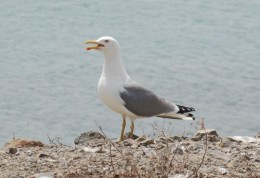 The biggest danger, both for hatching eggs and very young chicks, seems to be heat. Usually on a hot day all of the mothers are keeping their chicks and eggs in the shade, but if somebody comes close they have to fly up. If somebody was sitting near to a nest and keeping the mother off her eggs, then they would get too hot. Once we were having a barbecue on the beach with some friends. Unfortunately we discovered half way through the meal that there was a nest nearby. We had not imagined that there would be a nest right down there, by the sand. The mother had been having a hard time. Instead of sitting on her nest she stood beside it, nervously. We checked, and one of the three eggs was hatching.
The biggest danger, both for hatching eggs and very young chicks, seems to be heat. Usually on a hot day all of the mothers are keeping their chicks and eggs in the shade, but if somebody comes close they have to fly up. If somebody was sitting near to a nest and keeping the mother off her eggs, then they would get too hot. Once we were having a barbecue on the beach with some friends. Unfortunately we discovered half way through the meal that there was a nest nearby. We had not imagined that there would be a nest right down there, by the sand. The mother had been having a hard time. Instead of sitting on her nest she stood beside it, nervously. We checked, and one of the three eggs was hatching.
The next morning we checked the nest again, and there was a chick. One of the other eggs was cracking and the beak was peeping out. That was a relief – but unfortunately on that day somebody else came and had another barbecue on the remains of ours. The parents dive-bombed them, but not very fiercely and they wouldn’t go away. That evening we found that one of the remaining two chicks had hatched, but the third had died in its shell, with just its beak peeping out.
We moved the picnic site, so that people will have their parties further away and the nest will not be disturbed again.
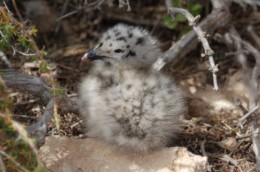 We also took the dead chick out of its shell, to have a look at it. It did not look as big-headed as Remus did when he hatched. It must have been the opposite sex to him. But it had that same big yellow ball which we thought was the yolk, when Remus hatched, but which is actually a kind of enormous belly-button. I decided to take the chick home and preserve it in alcohol, as part of my collection. Xoë was on at me about it for hours afterwards when she saw it.
We also took the dead chick out of its shell, to have a look at it. It did not look as big-headed as Remus did when he hatched. It must have been the opposite sex to him. But it had that same big yellow ball which we thought was the yolk, when Remus hatched, but which is actually a kind of enormous belly-button. I decided to take the chick home and preserve it in alcohol, as part of my collection. Xoë was on at me about it for hours afterwards when she saw it.
“It’s morbid,” she told Mummy. “You shouldn’t let her. I can’t step out of my cabin with out being confronted by a bit of dead bird. She’s got a gull’s wings with meat dripping off them. She’s got a cormorant rotting all over the aft deck. And now you want to let her keep this corpse. I won’t have it; it’s like living in a graveyard.”
Actually, the chick isn’t doing very well. It seems to be shrivelling up. (The aforementioned cormorant is in a net bag, awaiting the services of the local crabs. Its skeleton will eventually be added to the Mollymawk Museum of Natural History. JDS)
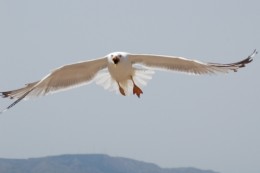 A chick’s dangers by no means stop when he is hatched. If a chick strays too far from its nest it is quite likely to be attacked by the other birds. We have found two dead chicks which had been attacked. One was stabbed in the back and the other was minus his head. We have actually seen larger chicks being attacked by adults, although they have always got away safely. Presumably they strayed too close to another nest, or perhaps there are some bullies amongst the gulls. We have also seen a sick adult being dive-bombed by one gull, just briefly. But most sick adults are not attacked.
A chick’s dangers by no means stop when he is hatched. If a chick strays too far from its nest it is quite likely to be attacked by the other birds. We have found two dead chicks which had been attacked. One was stabbed in the back and the other was minus his head. We have actually seen larger chicks being attacked by adults, although they have always got away safely. Presumably they strayed too close to another nest, or perhaps there are some bullies amongst the gulls. We have also seen a sick adult being dive-bombed by one gull, just briefly. But most sick adults are not attacked.
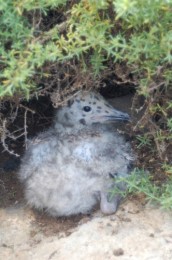 There are also predators who might kill a chick. There are snakes… as we have seen.
There are also predators who might kill a chick. There are snakes… as we have seen.
The snakes on Isla Perdiguera must live mostly on rabbit kittens, lizards, insects, and chicks. I have seen a snake twice. Once I saw a huge black one on the beach, and recently I saw a beautiful little patterned one in the bushes. My brother has also seen a black one, in the tunnel. He doesn’t like to go in the tunnel any more. I have also found two snakeskins, one small one and one which is huge. And, of course, there was that hissing from the bush near N8. I wonder where those chicks are. I have never seen them, ever… An animal as big as the one which shed the snakeskin could easily manage a chick. It could manage a large chick! Maybe it could even kill an adult.
Will the snakes get Roxanne? What will Remus eat next? When will the birds fly away?
Don’t miss next week’s exciting episode!
For the full story of Roxanne’s hand-reared gulls and her study of the yellow-legged seagull colony on Isla Perdiguera, buy her book, Two Gulls and a Girl.

Many thanx for that excellent account. Love reading it all!
Regards,
PS.
Great pic. of Remus cheeping/yawning/squawking!
PPS.
Will you be giving Remus a nom de plume now that s/he’s survived enough adventures to fill an autobirdography and s/he’s obviously got a gut-feeling for writing?
Sorry Patrick; Rox and JDS haven’t been able to get online for sometime, which is why they haven’t answered you.
Personally I’ve got a gut feeling Remus was nearly a ghost writer – but I suppose if he can stomach loosing his pencils, he’ll be all write.
Anyhow, I’m told that actually it’s not Remus who is having a change of name but Romulus – in keeping with
hisher sex change…Part IV is online now at https://www.yachtmollymawk.com/2008/05/seagull-survey-4/.